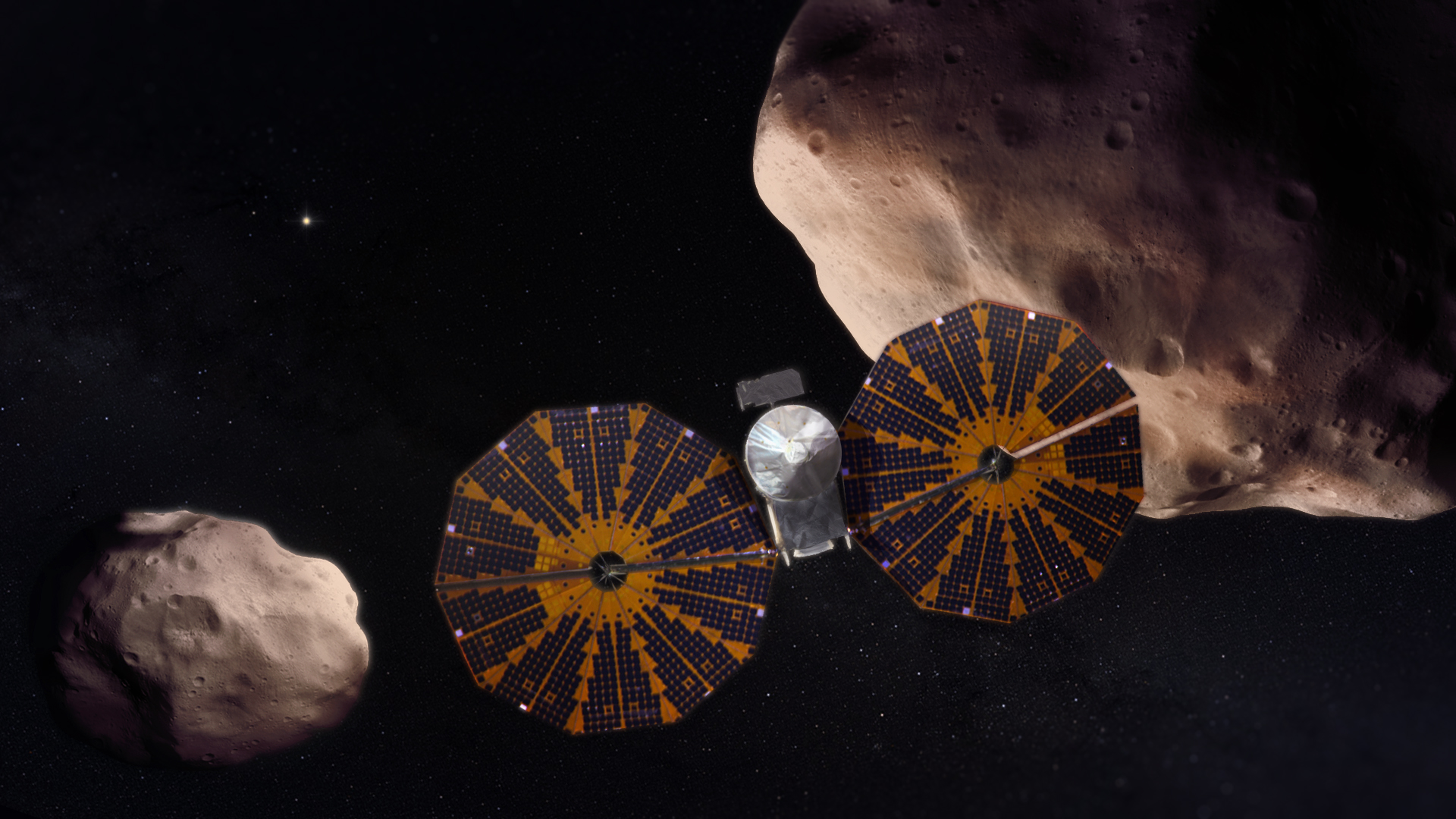NASA's asteroid-hopping Lucy probe on course for 1st space rock flyby in November
Lucy will become the first to investigate the Trojan asteroids near Jupiter, visiting a record number of space rocks beginning in late 2023.

NASA's asteroid-hopping Lucy spacecraft has adjusted course on its way to explore distant space rocks.
Lucy's current trajectory will see the probe visit the tiny asteroid Dinkinesh in November 2023. The spacecraft will stop off at this half-mile-wide asteroid before heading off to become the first craft to visit the Trojan asteroids that follow the orbit of Jupiter around the sun.
The course-adjusting maneuver was performed on May 9, as the Lucy spacecraft hurtled toward its target at 42,000 mph (67,590 km/h), or about 30 times as fast as a jet fighter's top speed. Though the operation changed the velocity of Lucy by just 7.7 mph (12 km/h), this shift is enough to alter its trajectory to bring it nearly 40,000 miles (65,000 kilometers) closer to Dinkinesh during the planned encounter on Nov. 1, 2023, NASA wrote in a statement.
Related: NASA's LUCY mission snaps its asteroid targets for the 1st time
The Trojan asteroids are a large group of space rocks that share the orbit of Jupiter, the solar system's largest planet. Astronomers believe that this family of asteroids is what remains of the material that formed the planets of the solar system over 4.5 billion years ago.
As such, studying these objects could reveal more about the celestial origins of Earth and of life itself. This investigation into our cosmic beginnings inspired NASA to name the craft "Lucy," which connects the spacecraft to the fossilized human ancestor of the same name. Just as the skeleton of Lucy provided unique insight into human evolution, NASA says it is hoped the Lucy mission will revolutionize our knowledge of planetary origins and the formation of the solar system.
During Lucy's flyby of Dinkinesh, it will pass the space rock at a distance of just 265 miles (425 kilometers) while traveling at around 10,000 miles per hour relative to the asteroid.
Breaking space news, the latest updates on rocket launches, skywatching events and more!
The tiny asteroid received its name in February. Dinkinesh, or ድንቅነሽ in the Ethiopian language Amharic, means "you are marvelous."
Lucy wasn't initially scheduled to visit Dinkinesh. The NASA spacecraft, which launched on Oct. 16, 2021, was set to visit just eight Trojan asteroids during its 12-year mission, but Dinkinesh was added as its first stop to provide an important opportunity to test some of the probe's instruments before it gets to the Trojans. In addition to serving as an important test flight, the visit to Dinkinesh will also reveal important information about the asteroid, the smallest main asteroid belt object ever explored by a space probe.
"This is really a tiny little asteroid," Southwest Research Institute (SwRI) planetary scientist and Lucy's principal investigator, Hal Levison, said about Dinkinesh in a statement in February. "Some of the team affectionately refer to it as 'Dinky.' But, for a small asteroid, we expect it to be a big help for the Lucy mission."
As Lucy continues its journey toward the Trojan asteroids, its operators will have the chance to continue to adjust the spacecraft's course. In addition to this, they will analyze the data collected during its visit to Dinkinesh and calibrate its instruments accordingly.
After Dinkinesh, Lucy's next stop is the main belt asteroid (52246) Donaldjohanson, which it should reach in April 2025. Following that stop, Lucy will visit eight Trojan asteroids between 2027 and 2033, gathering data on the different classes of space rocks it examines. NASA has previously stated that "no other space mission in history has been launched to as many different destinations in independent orbits around our sun."

Robert Lea is a science journalist in the U.K. whose articles have been published in Physics World, New Scientist, Astronomy Magazine, All About Space, Newsweek and ZME Science. He also writes about science communication for Elsevier and the European Journal of Physics. Rob holds a bachelor of science degree in physics and astronomy from the U.K.’s Open University. Follow him on Twitter @sciencef1rst.

